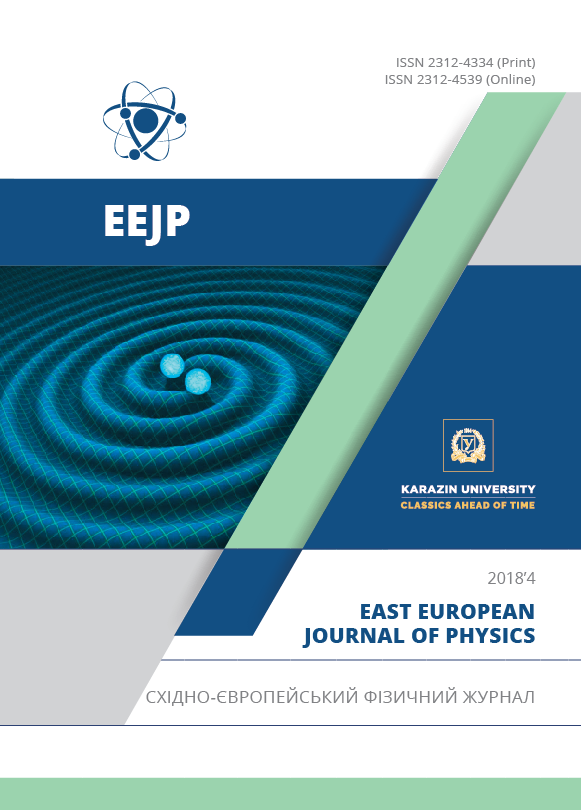Physical-Mechanical Properties of γ-Irradiated SiC Ceramics for Radioactive Wastes Immobilization
Abstract
The interest in silicon carbide (SiC-based) ceramics and composites as matrix material for nuclear waste immobilization is grown up. Long-term chemical durability and radiation resistance of SiC are important factors for radionuclides immobilization. Advantages of SiC-based ceramics as structural materials in nuclear applications are the high-temperature properties, high density and reduced neutron activation. The use of radiation resistant materials is a strong requirement for safe and environmentally beneficial energy system. The SiC ceramics stability under irradiation for temperatures up to 1273 K is also very important for nuclear power applications. The SiC matrices doped by additives of Cr, Si were fabricated using High Speed Hot Pressing Method. Additives content was in the range from 0.5 to 3 wt %. Microstructural characteristics of silicon carbide ceramics were analyzed by X-ray diffraction (XRD), scanning electron microscopy (SEM), energy-dispersive X-ray spectroscopy (EDX), and infra-red spectroscopy (IR) methods. The results of microcracking under indentation conditions were revealed the lack of cracks in the SiC ceramics with Cr additives before and after irradiation process. In addition, it was demonstrated that samples of SiC with alloying additives Cr and Si possess high mechanical parameters under γ-irradiation process. The strength of ceramics increases with the uniform and fine-grained structure formation. The modification of phase composition and mechanical properties of the SiC ceramics with Cr and Si additives under γ-irradiation were analyzed for further development of radiation resistant and matrix materials for radioactive wastes immobilization.
Downloads
References
L.L. Snead, R.H. Jones, A. Kohyama and P. Fenici, J. Nucl. Mater. 26, 233-237 (1996).
Y. Katoh, L.L. Snead, I. Szlufarska and W.J Weber, Current Opinion in Solid State and Materials Science. 16. 143-152 (2012).
Y. Katoh, L.L. Snead, T. Cheng, C. Shih, W.D. Lewis, T. Koyanagi and T. Hinoki, J. Nucl. Mater. 448, 497-511 (2014).
C.H. Henager, Y. Shin, Y. Blum, L.A. Giannuzzi, B.W. Kempshall and S.M. Schwarz, J. Nucl. Mater. 1139, 367-370 (2007).
R.A. Verrall, M.D. Vlajic and V.D. Krstic, Journal of Nuclear Materials. 274, 54-60 (1999).
B.A. Pint, K.A. Terrani, M.P. Brady, T. Cheng and J.R. Keiser, J. Nucl. Mater. 440, 420-427 (2013).
P. Fenici, A.J. Frias Rebelo, R.H. Jones, A. Kohyama and L.L. Snead, Journal of Nuclear Materials. 258-263, 215-225 (1998).
K.H. Sarma, J. Fourcade, S-G. Lee and A.A. Solomon, J. Nucl. Mater. 352, 324-333 (2006).
J.J. Powers, B.D. Wirth, J. Nucl. Mater. 405, 74-82 (2010).
Y. Katoh, K. Ozawa, C. Shih, T. Nozawa, R.J. Shinavski, A. Hasegawa and L.L. Snead, J. Nucl. Mater. 448, 448-476 (2014).
P.F. Tortorelli, K.L. More, J. Am. Ceram. Soc. 86, 1249-1255 (2003).
E.J. Opila, J. Am. Ceram. Soc. 82(3), 625-636 (1999).
M. Herrmann, W. Lippmann and A. Hurtado, J. Nucl. Mater. 443, 458-466 (2013).
J. Fachinger, M. den Exter, B. Grambow, S. Holgersson, C. Landesman and M. Titov, Nucl Eng Des. 236, 543-554 (2006).
J.L. Peterson, M.L. Dunzik-Gougar, Progr. Nucl. Energy. 53, 278-284 (2011).
S. Sorieul, J-M. Costantini, L. Gosmain, L. Thome and J-J. Grob, Journal of Physics: Condensed Matter. 18, 5235-5251 (2006).
T. Cheng, R.H. Baney and J. Tulenko, J. Nucl. Mater. 411, 126-130 (2011).
W.J. Weber, L. Wang, Y. Zhang, W. Jiang and I-T Bae, Nucl. Instrum. Methods Phys. Res. B. 266, 2793-2796 (2008).
L.L. Snead, Y. Katoh, A. Kohyama, J.L. Bailey, N.L. Vaughn and R.A. Lowden, J. Nucl. Mater. 283, 551–555 (2000).
C.J. McHargue, J.M. Williams, Nucl. Instr. and Meth. B. 80-81, 889-894 (1993).
M.G. Grimaldi, L. Calcagno, P. Musumeci, N. Frangis and J. Van Landuyt, J. Appl. Phys. 81, 7181-7185 (1997).
A. Audren, A. Benyagoub, L. Thome and F. Garrido, Nuclear Instruments and Methods in Physics Research B. 257, 227-230 (2007).
J.H. She, K. Ueno, Materials Research Bulletin. 34(10-11), 1629-1636 (1999).
Z.H. Huang, D.C. Jia, Ceramics International. 29, 13-17 (2003).
V.A. Izhevsikyi, L.A. Genova, International Journal of Refractory Metal & Hard Materials. 19, 407-409 (2001).
R.P. Jensen, E.W. Luecke, Materials Science and Engineering A. 282, 109-114 (2000).
Y.W. Kim, J.Y. Kim, Journal of the European Ceramic Society. 20, 945-949 (2000).
E. Liden, E. Carlstrom, Journal of the American Ceramic Society. 78(7), 1761-1768 (1995).
K. Lobach, Ye. Svitlychnyi, S. Sayenko, V. Voyevodin, A. Zykova, H. Ghaemi, M. Szkodo, G. Gajowiec, M. Kmiec and M. Antoszkiewicz, Problems of atomic science and technology. 108(2), 97-102 (2017).
A.G. Evans, E.A. Charles, Journal of the American Ceramic Society. 59, 371-372 (1976).
K. Niihara, J. Mater. Sci. Lett. 2, 221-223 (1983).
J. Wade, P. Claydon and H. Wu, in: Ceramic Engineering and Science Proceedings. Mechanical Properties and Performance of Engineering Ceramics and Composites IX. Vol. 35(2). Edited by Dileep Singh and Jonathan Salem (Wiley, Weinheim, 2014), pp. 91-100, doi: 10.1002/9781119031192.ch10.
D.O., Moskovskikh Y. Song, S. Rouvimov, A.S. Rogachev and A.S. Mukasyan, Ceramics International. 42, 12686-12693 (2016).
Van der Marel and H. Beutelspacher, Atlas of infrared spectroscopy of clay minerals and their admixtures, (Elsevier, Amsterdam, 1976), p. 396.
T. Merle-Mejean, E., Abdelmounm and P. Quintard, Journal of Molecular Structure. 349, 105-108 (1995).
Authors who publish with this journal agree to the following terms:
- Authors retain copyright and grant the journal right of first publication with the work simultaneously licensed under a Creative Commons Attribution License that allows others to share the work with an acknowledgment of the work's authorship and initial publication in this journal.
- Authors are able to enter into separate, additional contractual arrangements for the non-exclusive distribution of the journal's published version of the work (e.g., post it to an institutional repository or publish it in a book), with an acknowledgment of its initial publication in this journal.
- Authors are permitted and encouraged to post their work online (e.g., in institutional repositories or on their website) prior to and during the submission process, as it can lead to productive exchanges, as well as earlier and greater citation of published work (See The Effect of Open Access).








